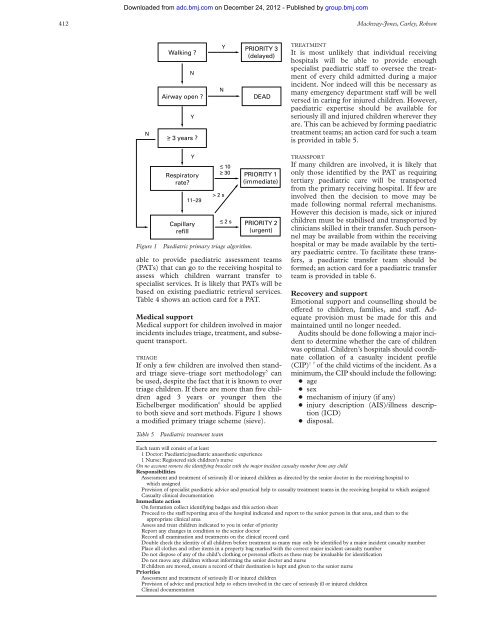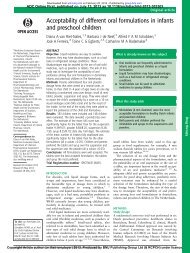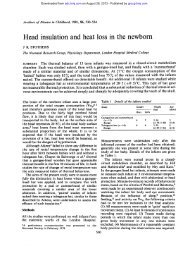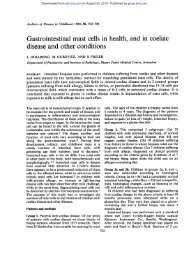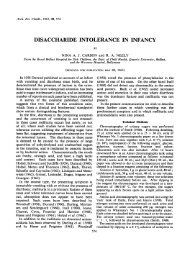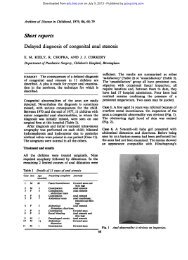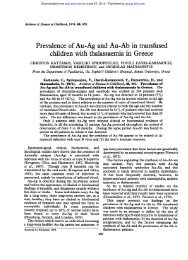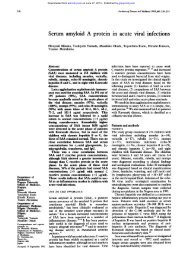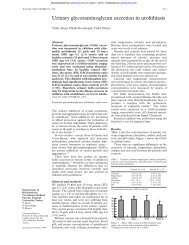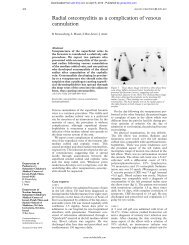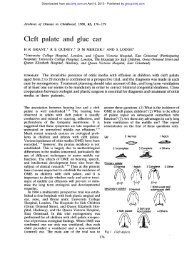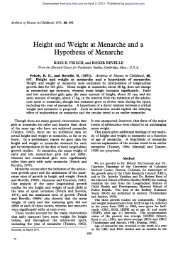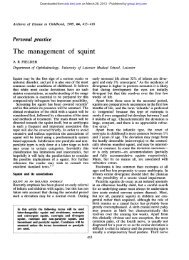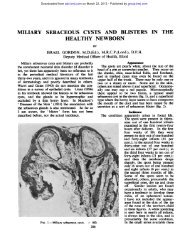Planning for major incidents involving children by ... - BMJ
Planning for major incidents involving children by ... - BMJ
Planning for major incidents involving children by ... - BMJ
You also want an ePaper? Increase the reach of your titles
YUMPU automatically turns print PDFs into web optimized ePapers that Google loves.
Downloaded from<br />
adc.bmj.com on December 24, 2012 - Published <strong>by</strong> group.bmj.com<br />
412 Mackway-Jones, Carley, Robson<br />
N<br />
Walking ?<br />
N<br />
Airway open ?<br />
Y<br />
> – 3 years ?<br />
Y<br />
Respiratory<br />
rate?<br />
11–29<br />
Capillary<br />
refill<br />
<<br />
– 10<br />
><br />
– 30<br />
Figure 1 Paediatric primary triage algorithm.<br />
able to provide paediatric assessment teams<br />
(PATs) that can go to the receiving hospital to<br />
assess which <strong>children</strong> warrant transfer to<br />
specialist services. It is likely that PATs will be<br />
based on existing paediatric retrieval services.<br />
Table 4 shows an action card <strong>for</strong> a PAT.<br />
Medical support<br />
Medical support <strong>for</strong> <strong>children</strong> involved in <strong>major</strong><br />
<strong>incidents</strong> includes triage, treatment, and subsequent<br />
transport.<br />
TRIAGE<br />
If only a few <strong>children</strong> are involved then standard<br />
triage sieve–triage sort methodology 5 can<br />
be used, despite the fact that it is known to over<br />
triage <strong>children</strong>. If there are more than five <strong>children</strong><br />
aged 3 years or younger then the<br />
Eichelberger modification 6 should be applied<br />
to both sieve and sort methods. Figure 1 shows<br />
a modified primary triage scheme (sieve).<br />
Y<br />
N<br />
> 2 s<br />
Table 5 Paediatric treatment team<br />
< – 2 s<br />
PRIORITY 3<br />
(delayed)<br />
DEAD<br />
PRIORITY 1<br />
(immediate)<br />
PRIORITY 2<br />
(urgent)<br />
TREATMENT<br />
It is most unlikely that individual receiving<br />
hospitals will be able to provide enough<br />
specialist paediatric staV to oversee the treatment<br />
of every child admitted during a <strong>major</strong><br />
incident. Nor indeed will this be necessary as<br />
many emergency department staV will be well<br />
versed in caring <strong>for</strong> injured <strong>children</strong>. However,<br />
paediatric expertise should be available <strong>for</strong><br />
seriously ill and injured <strong>children</strong> wherever they<br />
are. This can be achieved <strong>by</strong> <strong>for</strong>ming paediatric<br />
treatment teams; an action card <strong>for</strong> such a team<br />
is provided in table 5.<br />
TRANSPORT<br />
If many <strong>children</strong> are involved, it is likely that<br />
only those identified <strong>by</strong> the PAT as requiring<br />
tertiary paediatric care will be transported<br />
from the primary receiving hospital. If few are<br />
involved then the decision to move may be<br />
made following normal referral mechanisms.<br />
However this decision is made, sick or injured<br />
<strong>children</strong> must be stabilised and transported <strong>by</strong><br />
clinicians skilled in their transfer. Such personnel<br />
may be available from within the receiving<br />
hospital or may be made available <strong>by</strong> the tertiary<br />
paediatric centre. To facilitate these transfers,<br />
a paediatric transfer team should be<br />
<strong>for</strong>med; an action card <strong>for</strong> a paediatric transfer<br />
team is provided in table 6.<br />
Recovery and support<br />
Emotional support and counselling should be<br />
oVered to <strong>children</strong>, families, and staV. Adequate<br />
provision must be made <strong>for</strong> this and<br />
maintained until no longer needed.<br />
Audits should be done following a <strong>major</strong> incident<br />
to determine whether the care of <strong>children</strong><br />
was optimal. Children’s hospitals should coordinate<br />
collation of a casualty incident profile<br />
(CIP) 17 of the child victims of the incident. As a<br />
minimum, the CIP should include the following:<br />
+ age<br />
+ sex<br />
+ mechanism of injury (if any)<br />
+ injury description (AIS)/illness description<br />
(ICD)<br />
+ disposal.<br />
Each team will consist of at least<br />
1 Doctor: Paediatric/paediatric anaesthetic experience<br />
1 Nurse: Registered sick <strong>children</strong>’s nurse<br />
On no account remove the identifying bracelet with the <strong>major</strong> incident casualty number from any child<br />
Responsibilities<br />
Assessment and treatment of seriously ill or injured <strong>children</strong> as directed <strong>by</strong> the senior doctor in the receiving hospital to<br />
which assigned<br />
Provision of specialist paediatric advice and practical help to casualty treatment teams in the receiving hospital to which assigned<br />
Casualty clinical documentation<br />
Immediate action<br />
On <strong>for</strong>mation collect identifying badges and this action sheet<br />
Proceed to the staV reporting area of the hospital indicated and report to the senior person in that area, and then to the<br />
appropriate clinical area<br />
Assess and treat <strong>children</strong> indicated to you in order of priority<br />
Report any changes in condition to the senior doctor<br />
Record all examination and treatments on the clinical record card<br />
Double check the identity of all <strong>children</strong> be<strong>for</strong>e treatment as many may only be identified <strong>by</strong> a <strong>major</strong> incident casualty number<br />
Place all clothes and other items in a property bag marked with the correct <strong>major</strong> incident casualty number<br />
Do not dispose of any of the child’s clothing or personal eVects as these may be invaluable <strong>for</strong> identification<br />
Do not move any <strong>children</strong> without in<strong>for</strong>ming the senior doctor and nurse<br />
If <strong>children</strong> are moved, ensure a record of their destination is kept and given to the senior nurse<br />
Priorities<br />
Assessment and treatment of seriously ill or injured <strong>children</strong><br />
Provision of advice and practical help to others involved in the care of seriously ill or injured <strong>children</strong><br />
Clinical documentation


